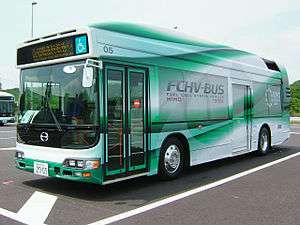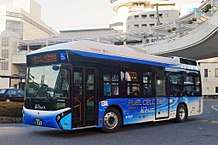Toyota FCHV
The Toyota FCHV is a current hybrid hydrogen fuel cell vehicle development programme of the Toyota Motor Corporation, which was leased to a limited number of drivers in the United States[1] and Japan beginning in 2002.[2] "FCHV" stands for "Fuel Cell Hybrid Vehicle". A number of prototypes have been produced, up to the latest FCHV-adv ("advanced").
History
There are currently five generations of the FCHV, beginning with preliminary prototypes FCHV-1 (1997) and FCHV-2 (1999). The FCHV-3 was presented at the "International Symposium on Fuel-Cell Vehicles" in March 2001 in Tokyo, and the FCHV-4 was the first production version, although Toyota did not plan a full-scale commercial hydrogen fuel cell vehicle launch until around 2015.
As of 2008 the FCHV-adv was available for lease in Japan.[2] The use of the vehicles by government ministries and companies is intended to provide detailed development feedback on the FCHV performance under varied driving conditions.
In 2007 a FCHV was driven 560 km (350 mi) between Osaka and Tokyo on a single tank of hydrogen, proving that a hydrogen vehicle could compete with conventional vehicles for range. In August 2009, Toyota USA announced an estimated FCHV-adv range of 690 km (430 mi) from a 6 kg (13 lb) tank of hydrogen, based on a 331.5-mile (533.5 km) test trip in "real-world" conditions between Torrance and San Diego, California.[3]
FCHV system
The FCHV designs are based on the first generation Highlander SUV, although a bus version is also in development. The powertrain consists of a 90 kW fuel cell supplied from onboard compressed hydrogen tanks, and a nickel–metal hydride battery in parallel. Battery and fuel cell can provide power to the 90 kW driving motors either singly or together. The mechanism is very similar to the Hybrid Synergy Drive in the Toyota Prius and Toyota Auris HSD but with the fuel cell replacing the petrol internal combustion engine, thus minimising greenhouse gas emissions at point of use.
At low speeds the FCHV can run on battery alone, with a range of about 50 km (31 mi).[2] For high performance, such as when accelerating from rest, the fuel cell and battery supply power in tandem. The battery can also charge by regenerative braking, improving overall efficiency.
Hydrogen storage
The 700 Bar (10000 PSI) hydrogen tanks holds 156 liters - enough fuel for a range of 830 kilometers (520 mi) on the Japanese 10-15 test cycle and 760 kilometers (470 mi) on the Japanese JC08 test cycle.[4] Test vehicles on the Japanese 10-15 test cycle average 22.7 kilometers per hour (14.1 mph) with a top speed of 70 kilometers per hour (43 mph).[5] Vehicles on the JC08 test cycle average 24.4 kilometers per hour (15.2 mph) and a top speed of 81.6 kilometers per hour (50.7 mph).[6]
Models
FCHV-1
FCHV-2
FCHV-3
FCHV-4
FCHV-adv
FCHV-BUS

The Toyota FCHV-BUS is a fuel cell bus based on the Hino Blue Ribbon City(KL-HU2PMEE) low-floor bus.
- 90 kW PEFC Fuel cell stack: twice
- Motor: AC synchronous 80 kW twice
- Hydrogen tank: Compressed hydrogen gas 35 MPa / 150 liter, five (version 2002) or seven (version 2005)
- Passenger capacity: 63 (included 22 seats)
FCHV-BUS demonstrated at Toei Bus (August 2003 - December 2004) and Expo 2005. After Expo 2005, some were lent to bus fleet operators, and also demonstrated in fuel cell events.
- Chita Noriai (March 2006 - December 2009) as route bus in Chubu International Airport
- Chubu International Airport (since July 2006) as ramp bus
- Meitetsu Bus (since October 2010) as route bus in Toyota City, Aichi
- Airport Transport Service (since December 2010) as airport shuttle bus for Tokyo International Airport
FC Bus

The Toyota FC Bus was made from 2015.
SORA
The Toyota SORA will be made from 2018.
Project Portal trucks
Toyota started testing two Mirai fuel cells (114 kW each)[7] in a converted Kenworth T680 electric Class 8 semi-trailer truck in the Port of Los Angeles in April 2017 as part of 'Project Portal',[8][9] doing drayage for Toyota.[10] The truck has two motors for a combined 500 kW (670 hp) and 1,795 N⋅m (1,325 lb⋅ft) of torque, a 200 kW[11] 12 kWh battery, and a fixed gear ratio of 15.5:1.[11] It has a range of 320 km (200 mi)[12] determined by the size of the hydrogen tanks. It accelerates (empty) from 0–97 km/h (0–60 mph) in 7 seconds. The motors are mainly powered by the fuel cells rather than from the small battery.[13]
Cultural impact
Prophets of Science Fiction
The FCHV is featured in the Jules Verne episode of the Science Channel program Prophets of Science Fiction. Some measure of credit is given to Jules Verne in the episode, for helping to inspire the idea.
See also
References
- ↑ "Toyota FCHV Fact Sheet" (Press release). Toyota USA. 2008-09-11. Retrieved 2013-01-13.
- 1 2 3 "Toyota to Begin Leasing Advanced Fuel Cell Hybrid Vehicle" (Press release). Toyota Japan. 2008-08-29. Archived from the original on 2013-04-25. Retrieved 2013-01-13.
- ↑ "Toyota Fuel Cell Vehicle Demonstration Program Expands" (Press release). US: Toyota. Retrieved 2013-01-13.
- ↑ "Toyota FCHV". GAVE. 2008-09-04. Archived from the original on 2012-02-20. Retrieved 2013-01-13.
- ↑ "Japanese 10-15 Mode". DieselNet. Retrieved 2013-01-13.
- ↑ "Japanese JC08 Cycle". DieselNet. Retrieved 2013-01-13.
- ↑ Halvorson, Bengt (2017-04-19). "Scaling Up: Toyota Putting Mirai Hydrogen Fuel-Cell Tech in a Semi".
- ↑ Ohnsman, Alan (2016-11-17). "Toyota Adapting Its Hydrogen Car Technology To Power Exhaust-Free Heavy Trucks". Forbes. US. Retrieved 2017-04-22.
- ↑ Ohnsman, Alan (2017-04-19). "Toyota Rolls Out Hydrogen Semi Ahead Of Tesla's Electric Truck". Forbes. US. Retrieved 2017-04-19.
- ↑ O'Dell, John (2017-10-12). "Toyota's Heavy-Duty Fuel Cell Truck Finally Hits the Road". Retrieved 2017-11-21.
- 1 2 Halvorson, Bengt (2017-04-21). "Electric Semis Won't Just Be Cleaner, They'll Be Quicker [Video]".
- ↑ "Toyota Opens a Portal to the Future of Zero Emission Trucking" (Press release). US: Toyota. 2017-04-19. Retrieved 2017-04-28.
- ↑ Esterdahl, Tim (2017-09-08). "A Ride Around the Track in Toyota's Hydrogen Fuel Cell Powered Semi Truck". Retrieved 2017-11-21.
Incredibly, the rig returns a 7.0 second 0-60 mph time. it runs off hydrogen fuel cells and the battery is a boost. Our system is to keep the battery as small as possible and really show the scalability of the fuel cell itself. The fuel cell is providing all of that power.
External links
| Wikimedia Commons has media related to Toyota FCHV. |